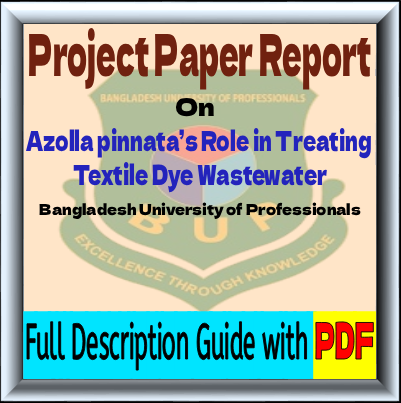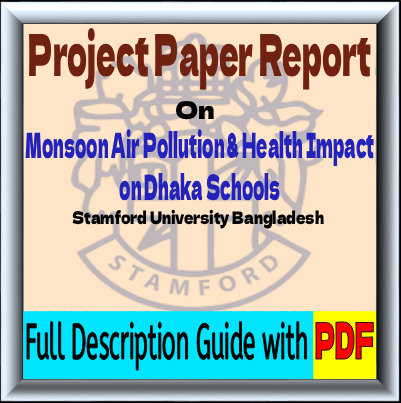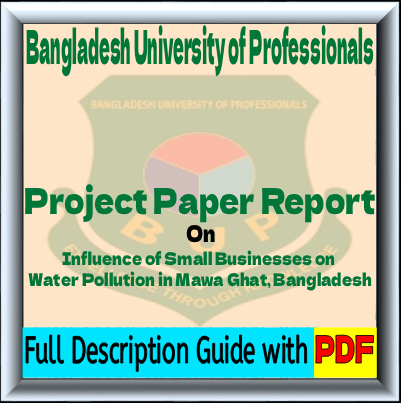
In particular, the disburdened water which consists of active component such as dyes and coloration for the finishing of different fibers is mostly very dangerous to human health as well as aquatic diversity. In the past few decennial, large-scale wastewater discharge from Bangladesh`s textile industries poses a significant threat to both side of society and the environment of Bangladesh.
This report was handled to investigate the qualification of Azolla pinnata in enhancing the water quality of various attention of textile dye wastewater. Some physic-chemical variable as a example- Temperature, TSS, TDS, DO, pH, EC, Turbidity, Salinity, Chemical Oxygen Demand (COD), Biological Oxygen Demand (BOD5) of the textile dye wastewater were followed before and after manifestation of Azolla pinnata without pH adaptation.
| Report Title : | Azolla pinnata`s Role in Enhancing Textile Dye Wastewater Quality. |
| University Name : | Bangladesh University of Professionals |
| Submitted To : | Md. Arifur Rahman Bhuiyan |
| Submitted By : | Nishat Tasnim |
| Total Page : | 77 |
Background of the Study
In the fiscal year 2024-2025, (July-January) Bangladesh exported garments worth US $23.55 billion, (Government of the People’s Republic of Bangladesh, 2025). Its more than 80% of export revenue is generated from the textiles and items that involve textiles. The textile industry endows about 13% of the GDP.

Approximately 4.0 million people are employed by these industries, 80% of them are women. The textile sector is renowned for its collective profitable contributions to the economy, but it is also well-known for its significant environmental and social challenges in terms of long-term acceptability. In spite of significant economic contributions, Bangladesh textile industries has a range of environmental problems; principally it pollutes the water resources.
Key Analytical Highlights
- Purpose of research: Testing the effectiveness of Azolla Pinnata to improve the quality of textile waste water.
- Improved water criteria: Temperature, TSS, TDS, PH, EC, Turbidity, Salt, COD, BOD5.
- Positive results: After processing by Azolla, dissolved oxygen (D) has increased.
- Best Results: 1% of Waste Water Density (T1) has shown the most effective refinement.
- Environmental Impact: Azolla Pinnata is an affordable, biological and environmentally friendly alternative, which is much more effective than expensive chemicals/electrochemical methods.
- Principal Insight: Many small factories can accept this biological solution even if they cannot afford expensive treatment plants.
Problem Statement
Rapid Growth, Rising Waste
The textile sector in Bangladesh it’s going to be booming. It brings in revenue, creates jobs, and puts the country on the global fashion map. But there’s a downside that’s not talked about enough. In this textile sector huge amount of water and chemicals it uses every day and it’s growing day by day.
Heavy use of Chemicals
During the dyeing and finishing of textile factories it`s used loads of chemicals such as- dyes, brighteners, softeners you name it. These don’t going to disappear. They end up in the wastewater and mess up the natural balance of our rivers.
Toxic Impact on Nature and People
This polluted water flows into the rivers and lakes without proper treatment as a result bad things happening such as- Fish die, water turns dark and smelly, and over time, people nearby may develop health issues skin rashes, breathing trouble, even worse and more on.
Existing Treatment Methods
Sure, there are methods out there to clean textile wastewater:
- Adsorption
- Photolysis
- Precipitation
- Chemical treatment
- Electrochemical processes
Limitations of Current Technologies
The big factories may install treatment plants, but what about the smaller units? Many of them can’t afford the tech or don’t follow the rules. As a result, a large chunk of untreated or half-treated water keeps getting dumped into natural sources every single day.
So, What Can Be Done?
Maybe it’s time we look beyond just chemicals and machines. Some implicit fixes could be:
- Low-cost biological treatments
- Strict rules that are actually enforced
- Helping small factories adopt better practices
- More awareness at all levels from owners to workers
Research Question
- The quality of textile dye wastewater is improving by treating with Azolla pinnata?
- In which concentration of textile dye wastewater, Azolla pinnata works most efficiently to enhance the water quality?
Research Objectives
- To determine the efficacy of Azolla pinnata in improving the water quality of collected textile dye wastewater.
- To determine the concentration in which Azolla pinnata performs most effectively to treat the textile dye wastewater.
Outline of the Report
The next chapters are organized as follows
- Literature Review Chapter: Literature Review Under this chapter the local and international articles which are related to the thesis topic are reviewed and summarized and the research gaps are mentioned.
- Conceptual Framework Chapter: Conceptual framework under this section the abstract representation of the research study was delineated which is connected with the research study goal that directs the collection and analysis of data. Methodology Under this section the detail information about samples and data collection as well as the methodology of experiment and data analysis is described.
- Results & Discussion Chapter: 7 Results and Discussions Under this chapter the results obtained from the experimental work and data analysis are interpreted and discussed elaborately.
- Conclusion Chapter: Conclusion Under this chapter some conclusions are given.
- References & Appendix: All supportive document, tables, figures are listed here.
Conclusion
Now-a-days, Aquatic Macrophyte based Systems (AMS) are a significant modern technique for treating wastewater and eliminating adverse substances. The cultures of Azolla pinnata in the wastewater that contains dye elements in it, effectively eliminated Temperature, pH, BOD, COD, EC, TSS, TDS, Turbidity, Salinity and Absorbance in comparison to the control treatment and standards for industrial waste prescribed by DoE. Furthermore, the treatments increased the dissolved oxygen (DO) level in the wastewater.
However, among the three textile dye wastewater containing treatments, the T1 (30%) have shown the most efficient results in improving all the mentioned water quality parameters. This study suggests that Azolla pinnata can be a promising agent for the treatment of textile dye wastewater; which will ultimately benefit the surface water system.
Frequently asked Questions (FAQS)
- Question 01: Why is the textile dye waste of Bangladesh dangerous?
- Answer: Because it contains harmful colors, chemicals and toxins, which pollute the river, kill fish and cause skin and respiratory problems in the surrounding people.
- Question 02: What role does Azolla Pinnata play in the purification of waste water?
- Answer: The Azolla Pinnata absorbs contaminants, reduces harmful ingredients like cod, bod, TSS and salinity and increases dissolved oxygen (D), thus making water relatively safe.
- Question 03: Which density waste water Azolla Pinnata most effectively refined?
- Answer: 5% density (T1) has shown the most effective improvement in all the criteria of waste water tested.
- Question 04: Why is the chemical method better than the chemical method?
- Answer: It is affordable, environmentally friendly, and especially for small textile factories, who cannot afford expensive treatment plants.
- Question 05: How can this research help students and future researchers?
- Answer: It provides a prepared project paper report, where methods, results and environmental aspects are highlighted – which is helpful for references, academic studies and practical solutions.











